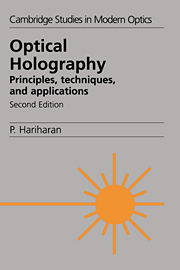Book contents
- Frontmatter
- Contents
- Preface
- Preface to the first edition
- 1 Introduction
- 2 Wavefront reconstruction
- 3 The reconstructed image
- 4 Types of holograms
- 5 Optical systems and light sources
- 6 The recording medium
- 7 Practical recording materials
- 8 Holograms for displays
- 9 Colour holography
- 10 Computer-generated holograms
- 11 Special techniques
- 12 Applications in imaging
- 13 Holographic optical elements
- 14 Information storage and processing
- 15 Holographic interferometry
- 16 Holographic interferometry: Further applications
- 17 Holographic interferometry: Advanced techniques
- 1 Interference and coherence
- 2 The Fourier transform, convolution, and correlation
- 3 Wave propagation and diffraction
- 4 Speckle
- 5 The H & D curve
- Bibliography
- References
- Author index
- Subject index
11 - Special techniques
Published online by Cambridge University Press: 05 June 2012
- Frontmatter
- Contents
- Preface
- Preface to the first edition
- 1 Introduction
- 2 Wavefront reconstruction
- 3 The reconstructed image
- 4 Types of holograms
- 5 Optical systems and light sources
- 6 The recording medium
- 7 Practical recording materials
- 8 Holograms for displays
- 9 Colour holography
- 10 Computer-generated holograms
- 11 Special techniques
- 12 Applications in imaging
- 13 Holographic optical elements
- 14 Information storage and processing
- 15 Holographic interferometry
- 16 Holographic interferometry: Further applications
- 17 Holographic interferometry: Advanced techniques
- 1 Interference and coherence
- 2 The Fourier transform, convolution, and correlation
- 3 Wave propagation and diffraction
- 4 Speckle
- 5 The H & D curve
- Bibliography
- References
- Author index
- Subject index
Summary
Polarization recording
With normal holographic techniques, the amplitude and phase of the object wavefront are recorded accurately, but information on its state of polarization is lost. The polarization of the reconstructed wave is determined by the polarization of the light used to illuminate the hologram.
Orthogonally polarized reference beams
Two basic methods for recording the state of polarization of the object wave have been described. The first method was proposed by Lohmann [1965a] and subsequently demonstrated by Bryngdahl [1967]. The experimental arrangement for this method, which is shown in fig. 11.1, uses two orthogonally polarized reference waves which interfere with the corresponding polarized component of the light from the object, so that two holograms are recorded on the same plate. After processing, when the plate is illuminated once again with the same reference beams, it yields two superimposed images that reproduce the polarization of the object wave. Care must be taken to adjust the angles of incidence of the beams so that the cross-talk images formed by diffraction of each of the reference beams at the hologram formed with the orthogonally polarized component do not overlap the desired image.
Coded reference beams
The other method, which is due to Kurtz [1969], uses a single reference beam in which, as shown in fig. 11.2, an opal glass diffuser is inserted. The light transmitted by this diffuser is depolarized, and the complex amplitudes of the two orthogonally polarized components of the reference beam at any point exhibit little or no correlation.
- Type
- Chapter
- Information
- Optical HolographyPrinciples, Techniques and Applications, pp. 181 - 196Publisher: Cambridge University PressPrint publication year: 1996

